California Housing Market: Prices, Trends, Forecast 2023
by Marco Santarelli
May 5, 2023
The California Association of Realtors (CAR) has released its report on the California housing market, indicating that higher interest rates contributed to a small drop in home sales in March 2023. Despite the dip, the demand for housing in the state remains strong, with homes selling quickly and at improved sales-to-list price ratios, and limited inventory. California’s median home price also recorded a healthy increase on a month-to-month basis for the first time in seven months, reaching $791,490 in March 2023.
California Home Sales in March 2023
Closed escrow sales of existing, single-family detached homes in California totaled a seasonally adjusted annualized rate of 281,050 in March 2023. This number is down 1% from February and down 34.2% from a year ago. Sales of existing single-family homes in California remained below the 300,000-unit pace for the sixth consecutive month.
At the regional level, all regions except the Central Valley (-27.7%) continued to record annual sales declines of more than 30%, with the Far North dropping the most at -38.9%. Sales in four of the six counties in the region dipped more than 40% from a year ago. The San Francisco Bay Area followed closely behind with a sales decrease of 35.5% from a year ago, while Southern California (-33.8%) and Central Coast (-31.2%) both declined sharply from last March.
ALSO READ: Will the US Housing Market Crash?
All but one of the 51 counties tracked by CAR experienced a sales drop from a year ago in March 2023, with 35 counties dropping more than 30% year-over-year and five counties plummeting more than 50% from last March. Extreme weather conditions throughout the state in the past few weeks had a negative impact on the housing market, which contributed to sharp sales declines in some of these counties.
California Home Prices in March 2023
California’s median home price grew for the first time in seven months in March 2023, increasing 7.6% from February’s $735,480 to $791,490. March’s price also was lower on a year-over-year basis for the fifth consecutive month, declining 7.0% from the revised $851,130 recorded last March.
At the regional level, median home prices dropped from a year ago in all major regions, with prices in three of the five regions declining more than 10% year-over-year in March 2023. Home prices in the San Francisco Bay Area continued to drop most of all regions, even though it was no longer the only region with a double-digit decline. With prices in five counties falling over 10% year-over-year, the median price for the Bay Area region was down 12.8% from March 2022.
Market Outlook
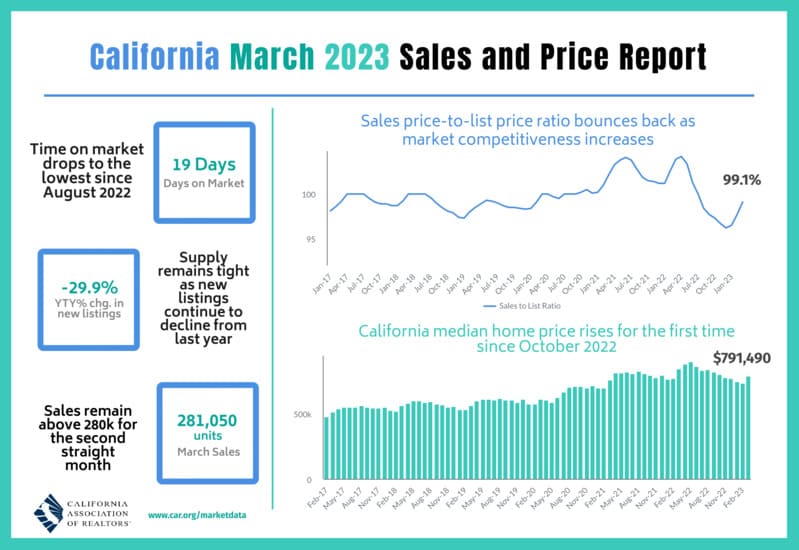
Despite a dip in March 2023 home sales, the competitiveness in the housing market continues to heat up, as homes are selling faster, and the sales-to-list-price ratio is improving, all the while when the number of homes available for sale continues to tighten, said C.A.R. President Jennifer Branchini, a Bay Area REALTOR®. All signs point to a market with solid demand, which should help bolster sales through the home-buying season.
While home sales continue to hover below the 300,000-unit annualized pace, the market seems to have weathered more aggressive rate hikes and banking failures quite well in the last few weeks, said C.A.R. Vice President and Chief Economist Jordan Levine. If interest rates stabilize or even improve in the next couple of months, home sales should rise during the peak home-buying season, and prices will likely follow suit due to high demand and limited inventory.
However, the supply chain disruptions, including those related to COVID-19 and extreme weather conditions, will likely continue to impact home sales in certain areas. Overall, the California real estate market remains competitive, with high demand for housing and limited inventory.
California Housing Market: Regional Trends
It’s clear that the California housing market has been impacted by a variety of factors, including the pandemic and economic changes. However, with strong demand for housing, it’s likely that the market will continue to be competitive, with prices remaining relatively high.
San Francisco Bay Area: As mentioned in the report, the Bay Area saw the biggest decline in median home prices compared to last year, with a drop of 12.8% in March 2023. This region has been hit hard by the pandemic, with many tech companies allowing employees to work remotely, which has led to an exodus from the area. As a result, inventory has increased, leading to lower prices.
Southern California: Southern California also saw a significant decline in home sales, dropping 33.8% from last March. However, the region saw a more modest decline in median home prices, dropping 3.4% from last year. This region has a diverse economy, with many industries still operating in person, which may be why home prices have remained more stable.
Central Coast: The Central Coast region saw a 31.2% decline in home sales and a 6.2% decline in median home prices compared to last year. This region has been impacted by the severe drought in California, which has led to concerns about the availability of water for homes and agriculture. Additionally, the region has a large number of second homes, which may not be as in demand as primary residences during the pandemic.
Central Valley: While the Central Valley was the only region to see an increase in home sales compared to last year, with a 2.2% increase, the region also saw a 1.3% decline in median home prices. This region has a more affordable housing market compared to other parts of California, which may be attracting buyers looking for more affordable options.
Far North: The Far North region saw the biggest decline in home sales, dropping 38.9% from last year. The region also saw a 6.9% decline in median home prices. This region has been impacted by the recent wildfires in California, which has led to concerns about the safety of homes in the area.
- San Francisco Bay Area had the highest year-over-year price decline of 12.8 percent, with the median price being $1,228,000.
- Southern California had a year-over-year price decline of 4 percent, with the median price being $770,000.
- The Central Coast had a year-over-year price decline of 12.1 percent, with the median price being $922,500.
- The Central Valley had a year-over-year price drop of 8.4 percent, with the median price being $453,550.
- The Far North had the highest year-over-year drop of 10.1 percent, with the median price being $355,000.
California Housing Market Forecast 2023-2024
Here’s the California Housing Forecast for 2023 released by the C.A.R. on October 12, 2022. A modest recession caused by an ongoing battle against inflation will keep interest rates elevated to suppress buyer demand and contribute to a weaker housing market in 2023, according to a housing and economic forecast released today by the CALIFORNIA ASSOCIATION OF REALTORS®. High inflationary pressures will keep mortgage rates high, reducing purchasing power and lowering property affordability for prospective purchasers in the coming year. As a result, housing demand and prices will fall throughout 2023.
- Existing, single-family home sales are forecast to total 333,450 units in 2023, a decline of 7.2 percent from 2022’s projected pace of 359,220.
- California’s median home price is forecast to decline 8.8 percent to $758,600 in 2023, following a projected 5.7 percent increase to $831,460 in 2022.
- Housing affordability is expected to drop to 18 percent next year from a projected 19 percent in 2022.
According to C.A.R.’s “2023 California Housing Market Forecast,” existing single-family home sales will fall 7.2 percent next year to 333,450 units, down from 359,220 units in 2022. The forecast for 2022 is 19.2 percent lower than the 444,520 residences sold in 2021. The median home price in California is expected to drop 8.8 percent to $758,600 in 2023, after rising 5.7 percent to $831,460 in 2022 from $786,700 in 2021. Next year’s median price rise will be slowed by a less competitive housing market for homebuyers and a stabilization in the mix of home sales.
According to C.A.R.’s 2022 projection, the U.S. gross domestic product of 0.5 percent in 2023, after a projected uptick of 0.9 percent in 2022. With California’s 2023 nonfarm job growth rate at 1.0 percent, up from a projected increase of 4.9 percent in 2022, the state’s unemployment rate will edge up to 4.7 percent in 2023 from 2022’s projected rate of 4.4 percent.
Stubbornly high inflation and growing economic concerns will keep the average for 30-year, fixed mortgage interest rates elevated at 6.6 percent in 2023, up from 5.2 percent in 2022 and from 3.0 percent in 2021 but will remain relatively low by historical standards.
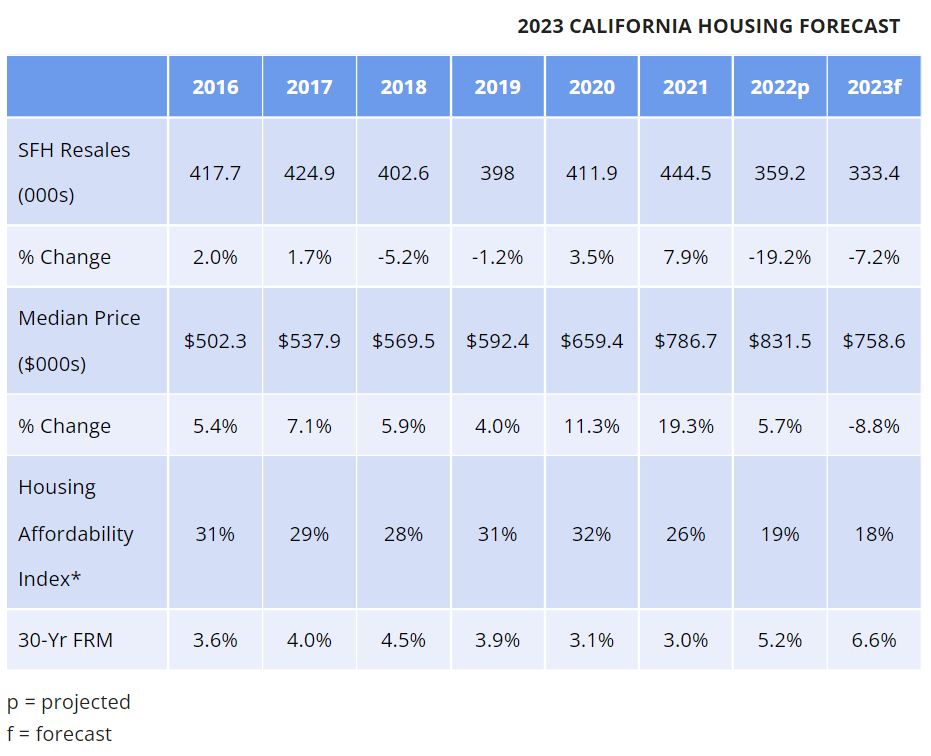
Housing Market Forecast for California Metro Areas
Let us look at the price trends recorded by Zillow over the past year. Based on Zillow’s data and CAR’s data, the California housing market is expected to experience a slowdown in 2023 and 2024. According to Zillow, the average home value in California is $728,134, down 1.7% over the past year, and homes go pending in around 24 days. Zillow’s data also shows that 29.9% of sales go over the list price, while 55.1% go under the list price, indicating that the market is becoming more favorable for buyers.
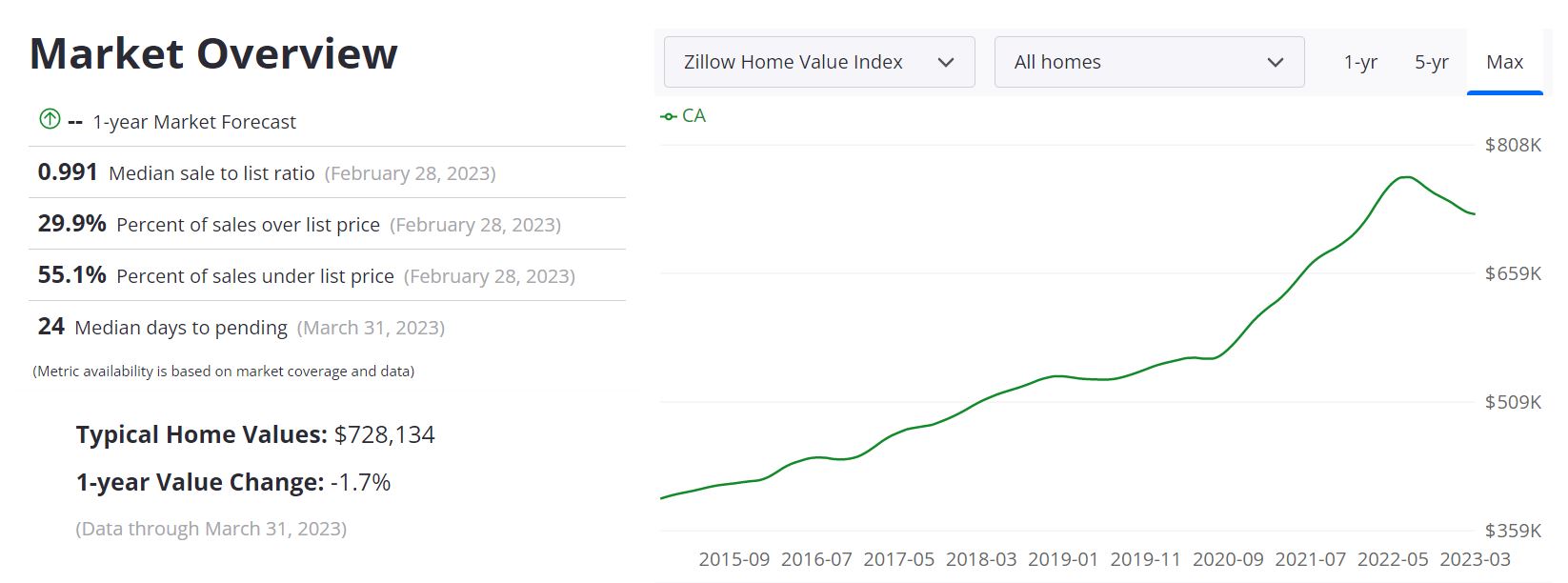
Zillow also provides insights into the forecast for various metro areas in California. The California housing market is expected to experience a slowdown in 2023 and 2024, with some metro areas experiencing modest growth while others may experience a decline in housing prices. The market is becoming more favorable for buyers, as the percentage of sales going under the list price is increasing.
However, it is important to note that housing market forecasts are subject to change, and various factors such as economic conditions, interest rates, and government policies can have an impact on market trends. According to the data, some of the popular MSAs in California, such as San Jose, San Francisco, and Vallejo, are expected to experience a decline in housing prices. For instance, San Jose is expected to experience a decline of 1.1% in housing prices by the end of April 2023 and a further decline of 2.2% by the end of June 2023.
Similarly, San Francisco is expected to experience a decline of 0.1% in housing prices by the end of April 2023 and a further decline of 0.7% by the end of June 2023. Other metro areas, such as Santa Rosa, are expected to experience a modest growth of 0.2% in housing prices by the end of April 2023, followed by a decline of 0.4% by the end of June 2023.
Additionally, areas like Bakersfield and Hanford are expected to experience moderate growth in housing prices by the end of March 2024. For instance, Bakersfield is expected to experience growth of 0.1% by the end of April 2023, 0.1% by the end of June 2023, and 1.5% by the end of March 2024. Hanford is expected to experience growth of 0.4% by the end of April 2023, 0.5% by the end of June 2023, and 1.7% by the end of March 2024.
California Housing Market – Weekly Report – April 17, 2023
Based on the data released on April 17, 2023, the California Housing Market continues to face challenges. Last week’s economic data indicated that the US economy is slowing down due to the lagged effects of monetary policy tightening, resulting in a decline in retail sales and inflation. Despite this, prices for core goods and services remain high, leading to the likelihood of the Fed raising rates at their upcoming meeting in May.
Californians continue to face inventory challenges due to fewer REALTORS® listing properties, with inventory expected to worsen before improving. Housing affordability for all Californians has decreased, with soaring home prices and high-interest rates causing a decrease in the number of households that can afford the median-priced home. The disparity in housing affordability for Black and Hispanic/Latino households highlights the homeownership gap and wealth disparity for communities of color.
Meanwhile, consumer prices have cooled off but remain elevated, with core CPI staying above 5% for 16 consecutive months. Retail sales fell for the second month in a row, indicating a gradual loss of momentum in consumer spending. Despite consumers adjusting their expectations around inflation, their sentiment remains stable, with the University of Michigan’s index showing a slight increase in consumer sentiment. Short-term inflation expectations have increased, but long-term expectations remain steady.
Is It a Good Time to Buy a Home in California?
The daily average for the week ending April 15, 2023, was 368 closed sales per day, 229 pending sales per day, and 181 new listings per day. The percentage of REALTORS® who believe sales will increase in the foreseeable future decreased to 54.2%, a decline of 6.9% from the previous week’s survey. According to C.A.R., 27.4% of REALTORS® polled believe that prices will increase, an increase of 8.2% from the previous week’s survey. The proportion of responders who think that listings will increase was 65%, a drop of 7.4% from the previous week.
Based solely on the information provided, it is difficult to determine whether it is a good or bad time to buy a home in California. While there is a decrease in the percentage of REALTORS® who believe sales will increase, there is also an increase in the percentage of REALTORS® who believe prices will increase. Additionally, there is a lack of inventory due to a shortage of listings, which may impact the market.
The decision to buy a home in California ultimately depends on an individual’s financial situation and personal preferences. However, recent trends in the housing market indicate that it may be a challenging time for buyers. The decrease in the Fannie Mae Home Purchase Sentiment Index® and the concerns about job security and selling a home may cause potential buyers to become more cautious.
Additionally, the low inventory of homes for sale and the high demand from buyers has created a competitive market, which could make it difficult to find a home at an affordable price. The recent uptick in mortgage rates could also make it more expensive to finance a home purchase.
Despite these challenges, some REALTORS® believe that sales will increase in the foreseeable future, and prices could go up. However, it’s worth noting that the housing market is unpredictable and can change quickly.
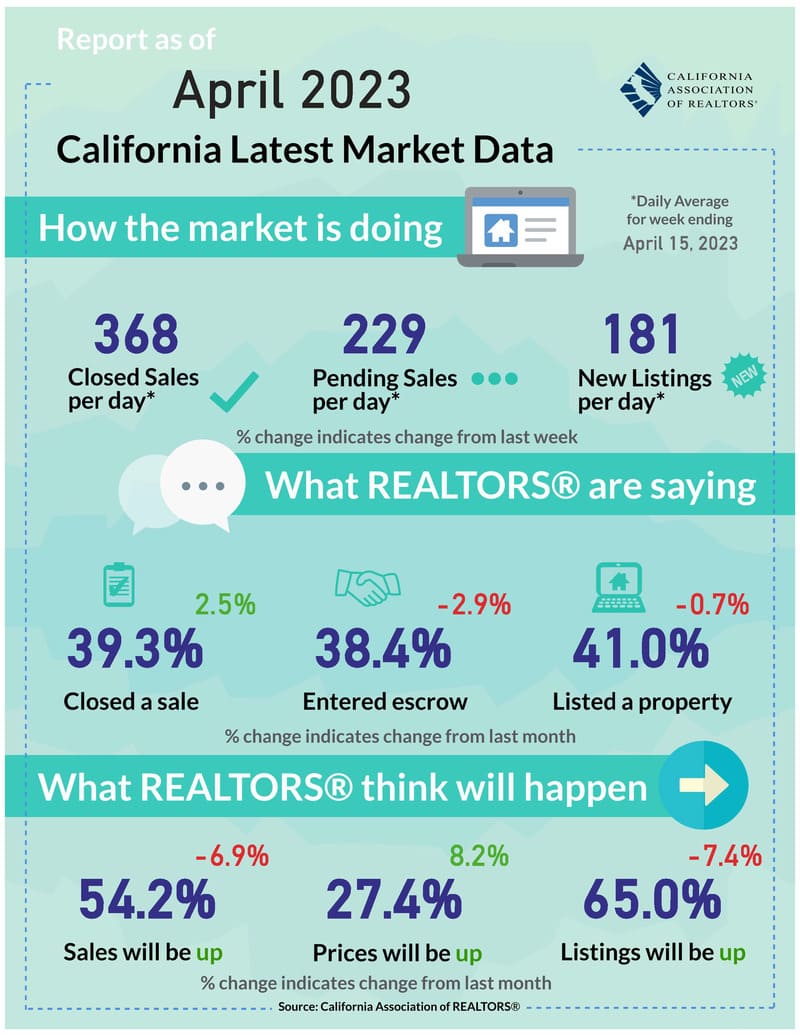
Housing Affordability Trends in California – 4th Quarter 2022
Housing costs have been on the rise in California, which has impacted affordability. According to C.A.R.’s Traditional Housing Affordability Index, the housing affordability in California for existing, single-family homes declined to 17% in the fourth quarter of 2022, pushing it slightly above the 15-year low recorded earlier in the year. This drop is due to the rapid rise in mortgage interest rates.
The statewide median price of a single-family home also dipped on a year-over-year basis for the first time in 11 years. The report suggests that home prices are expected to continue to decline due to high borrowing costs. The share of households that could afford to buy a median-priced condo/townhome in California also continued to slide, dropping to 26% in the fourth quarter of 2022 from 36% a year ago. However, nationwide housing affordability also slipped in the fourth quarter of 2022, with 38% of the nation’s households able to afford a median-priced home.
In the fourth quarter of 2022, the effective composite interest rate for a 30-year, fixed-rate loan was 6.80 percent, significantly higher than the 5.72 percent in the previous quarter and the 3.28 percent in the same quarter of the previous year. Despite the drop in housing affordability, the California housing market has seen some positive developments.
For instance, the statewide median price of an existing single-family home in California dipped on a year-over-year basis in the fourth quarter of 2022 for the first time in 11 years. This could potentially benefit homebuyers who have been struggling with high home prices in the state.
However, the decline in home prices is also indicative of softening demand in the market, which is expected to continue in the upcoming quarter as rates remain elevated. As a result, the market is likely to experience downward pressure on housing demand, which could potentially affect sales and inventory levels.
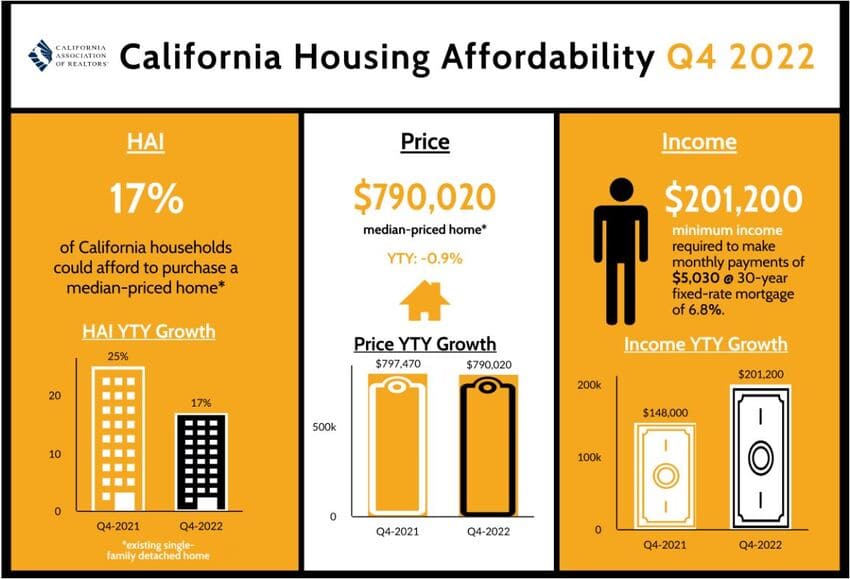
C.A.R.’s HAI measures the percentage of all households that can afford to purchase a median-priced, single-family home in California. C.A.R. also reports affordability indices for regions and select counties within the state. The index is considered the most fundamental measure of housing well-being for homebuyers in the state.
- Seventeen percent of California households could afford to purchase the $790,020 median-priced home in the fourth quarter of 2022, down from 18 percent in the third quarter of 2022 and down from 25 percent in the fourth quarter of 2021.
- A minimum annual income of $201,200 was needed to make monthly payments of $5,030, including principal, interest, and taxes on a 30-year fixed-rate mortgage at a 6.80 percent interest rate.
- More than one in four (26 percent) California home buyers were able to purchase the $610,000 median-priced condo or townhome.
- A minimum annual income of $155,200 was required to make a monthly payment of $3,880.
A full copy of this story can be read at its source: https://www.noradarealestate.com/blog/california-housing-market/
